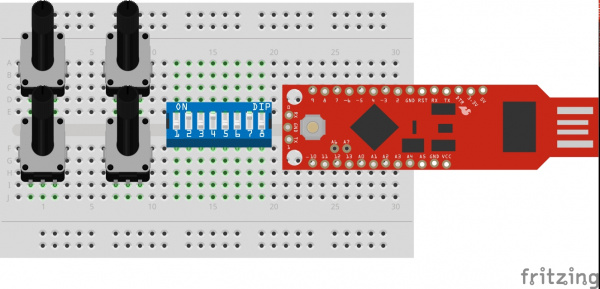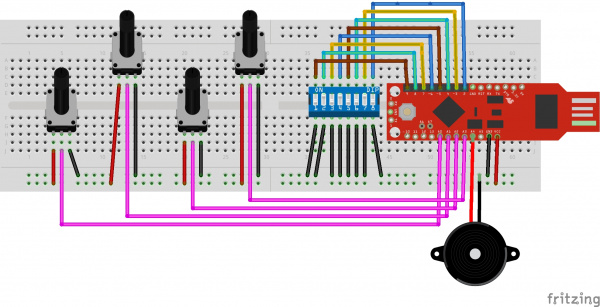BadgerHack: Synth Add-On Kit
Introduction
The BadgerStick that you received by visiting a SparkFun booth at one of the various events we've attended can be hacked to perform a wide variety of tasks. It can even make music, depending on your definition of music.
This tutorial will guide you through turning your BadgerStick into a little noise-making circuit that's easy to build, easy to program, and easy to alter and make your own!
Follow along with this guide and you'll be making sweet noise in no time!
Required Materials
We will need a few other components to make this thing work:
As you can see, the parts count is pretty low and none of the components we'll be using are very sophisticated. The BadgerStick (or RedStick) is doing all of the heavy lifting here. We just need a few control surfaces and a speaker.
Suggested Reading
Before starting this tutorial, we highly recommend you work through the main BadgerHack guide first.
BadgerHack
Additionally, if you are new to soldering or electronics, we recommend you check out the following:
When you are ready to start hacking your badge, we definitely recommend reading:
Hardware Hookup
Badger on a Breadboard
The BadgerStick is a great form factor for breadboard prototyping. If you have a fresh BadgerStick or RedStick out of the box, you can add male breakaway headers to both sides and sink it right into the breadboard over the gap. Make sure to add headers to pins A0 through VCC and pins 2 through 9. The holes on the BadgerStick are staggered so that the headers will stay in place while you solder them, simply snap off two strips of 8 headers and press them into place before securing them with a series of solder joints.
I'm going to assume for the purposes of this tutorial, however, that you've already assembled the BadgerStick into an interactive badge and therefore already have female right-angle headers installed on pins 2 through 9. You can use male right angle headers to mate your BadgerStick/RedStick to the breadboard instead of having to desolder those headers. Alternatively, you can desolder the headers and replace them with straight male headers.
A Jungle of Jumper Wires
A pack of jumper wires on our site contains 30 jumpers. Today, we're going to be using every single one of those. Start by placing all of your parts on the breadboard like this:
The potentiometers in the above picture don't look like the ones I suggested in my wishlist, but they'll work the same way. Now, with the jumper wires, begin making the connections listed here:
| Connect this: | To This: | |||
|---|---|---|---|---|
| DIP Switch Pins 1-8 | BadgerStick Pins 2-9 | |||
| All Potentiometers' Pin 1 | GND Rail of Breadboard | |||
| All Potentiometers' Pin 3 | VCC Rail of Breadboard | |||
| All Potentiometers' Pin 2 | BadgerStick A0-A3 | |||
| Speaker Pin 1 | BadgerStick A4 | |||
| Speaker Pin 2 | BadgerStick A5 | |||
| GND Rail of Breadboard | BadgerStick GND | |||
| VCC Rail of Breadboard | BadgerStick VCC | |||
Once these connections have been made, your breadboard should look more or less like the image below. I did use a larger breadboard just so that there was enough room to clearly illustrate each jumper connection:
That wraps up the hardware portion of this hack, let's go take a look at the code!
Code
Plug the USB side of your BadgerStick into your computer. Make sure "BadgerStick" and the associated COM port are selected in the window below. Click "Run on Arduino."
Copy the code below, and upload it through the Arduino IDE.
language:c
/*BadgerSynth Example Sketch
February 2016
Written by Nick Poole
SparkFun Electronics
Code is released under the MIT License.
*/
#define SPEAKER A4
#define POT_A A0
#define POT_B A1
#define POT_C A2
#define POT_D A3
int x = 2;
int osc1 = 0;
int osc2 = 0;
int ran = 0;
int tempo = 0;
int note;
bool event = 0;
void setup() {
// Setup all of the DIP Switch pins as Inputs
for(int i = 0; i<10; i++){
pinMode(i, INPUT);
digitalWrite(i, 1);
}
}
void loop() {
// Read all of the potentiometers
tempo = analogRead(POT_A) * 10;
osc1 = map(analogRead(POT_B), 0, 1023, 200, 6000);
osc2 = map(analogRead(POT_C), 0, 1023, 0, 1000);
ran = analogRead(POT_D)/2;
if(x==10){x=2;} // Iterate through each step on our DIP Switch
for(int y = 0; y<tempo; y++){ // Time each event to trigger on tempo
if(digitalRead(x)==0){
if(event == 0){
note = random(osc1-ran, osc1+ran); // Allow for randomness to be set
tone(SPEAKER, note, osc2); // Create our tone
event = 1;}
}
else{noTone(SPEAKER);} // If the DIP Switch is off, shut up for a step
}
x++; event = 0;
}
This code steps through each pin on the DIP switch, reading the input to the BadgerStick. If a switch is open, the BadgerStick will make a noise based on the potentiometer inputs. Changing the potentiometers will change the random tones created by the BadgerStick.
Resources and Going Further
That's it! Go forth and make noise!
The code we've provided for you is the bare bones of a step sequencer, but there are a lot of sweet hacks and mods that you can make to get more functionality out of it. For more information on step sequencing with Arduino, check out my Auduino Step Sequencer Build.
Resources
Other BadgerHack Projects
Check out some of the other things you can make with the Badger:




